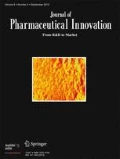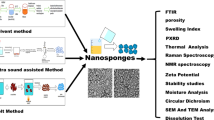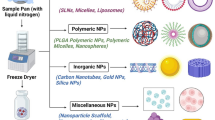Abstract
Purpose
Lyotropic liquid crystals (LLC) capable of flipping their structure according to varying pH environment of the GI tract were developed for colon-targeted delivery of 5-fluorouracil (5-FU).
Methods
A pH-sensitive LLC system loaded with 5-FU has been prepared by using different ratios of monoolein (MO) and oleic acid (OA) to facilitate drug targeting to the colon. The LLC batches were prepared utilizing different buffers, i.e., HCl buffer with pH 1.2 (indicative of gastric pH), acetate buffer with pH 4.5 (indicative of duodenum fluid pH), HEPES buffer with pH 6.8 (indicative of small intestinal fluid pH), and HEPES buffer with pH 7.4 (colon and rectum pH). The formulations were confirmed for liquid crystal phase formed by polarized light microscopy (PLM) and characterized by DSC, FESEM, drug content, rheology, texture analysis, in vitro drug release study and in vivo gamma-scintigraphic study.
Results
The PLM study confirmed the occurrence of both hexagonal and cubic phase liquid crystal depending on the pH and ratio of MO:OA used, which is further supported by the rheological determinations. The release study confirmed insignificant release of drug in the pH 1.2, pH 4.5, and pH 6.8 up to 5 h and major drug release in the colon and rectum pH up to 26 h showing more than 90% drug release in the colonic region by the formulation containing 40% MO and 60% OA.
Conclusions
The 5-FU release pattern from the pH-sensitive LLC formulation exhibits slow and extended release over longer periods of time owing to its ability to remain in less mucoadhesive hexagonal phase at lower pH environment causing slower release of drug and transforming into more mucoadhesive cubic phase at higher pH causing faster release of drug.









Similar content being viewed by others
References
Dhawale SC, Bankar AS, Patro MN. Formulation and evaluation porous microspheres of 5-fluorouracil for colon targeting. Int J Pharm Tech Res. 2010;2:1112–8.
Kopetz S. Targeted therapy in colorectal cancer. In: Kurzrock R, Markman M, editors. Targeted cancer therapy. Totowa: Humana Press; 2008. p. 101–45.
Zhang N, Yin Y, Xu SJ, Chen WS. 5-fluorouracil: mechanisms of resistance and reversal strategies. Molecules. 2008;13:1551–69.
Krishnaiah YSR, Satyanarayan S. Colon-specific drug delivery systems: advances in controlled and novel drug delivery: CBS Publishers and Distributors; 2001. p. 89–119.
Malmsten M. Surfactants and polymers in drug delivery. New York: Marcel Dekker Inc; 2006. p. 116–212.
Chen Y, Ma P, Gui S. Cubic and hexagonal liquid crystals as drug delivery systems. Biomed Res Int. 2014:1–12. https://doi.org/10.1155/2014/815981.
Lancelot A, Sierra T, Serrano JL. Nanostructured liquid-crystalline particles for drug delivery. Expert Opin Drug Deliv. 2014;11(4):1–18.
Yaghmur A, Glatter O. Characterization and potential applications of nanostructured aqueous dispersions. Adv Colloid Interf Sci. 2009;147-148:333–42.
Fong WK, Hanley T, Boyd BJ. Stimuli responsive liquid crystals provide ‘on-demand’ drug delivery in vitro and in vivo. J Control Release. 2009;135(3):218–26.
Angelov B, Angelova A, Garamus VM, Lebas G, Lesieur S, Ollivon M, et al. Small-angle neutron and x-ray scattering from amphiphilic stimuli-responsive diamond-type bicontinuous cubic phase. J Am Chem Soc. 2007;129(44):13474–9.
Renata N, Raffaele M. pH-responsive lyotropic liquid crystals for controlled drug delivery. Langmuir. 2011;27:5296–303.
Chang CM, Bodmeier R. Swelling of and drug release from monoglyceride-based drug delivery systems. J Pharm Sci. 1997;86(6):747–52.
Kwon TK, Kim JC. Monoolein cubic phase containing acidic proteinoid: pH-dependent release. Drug Dev Ind Pharm. 2011;37(1):56–61.
Chong JYT, Mulet X, Waddington LJ, Boyd BJ, Drummond CJ. High-throughput discovery of novel steric stabilizers for cubic lyotropic liquid crystal nanoparticle dispersions. Langmuir. 2012;28(25):9223–32.
Rosevear FB. The microscopy of the liquid crystalline neat and middle phases of soaps and synthetic detergents. J Am Oil Chem Soc. 1954;31:628–39.
Mandell L, Fontell K, Ekwall P. Occurrence of different mesomorphous phases in ternary systems of amphiphilic substances and water. In: Porter DS, Johnson JF, editors. Ordered fluids and liquid crystals, Advances in Chemistry Series, vol. 63. Washington, DC: American Chemical Society; 1967. p. 89–124.
Teagarden DL, Anderson BD, Petre WJ. Determination of the pH-dependent phase distribution of prostaglandin E1 in a lipid emulsion by ultrafiltration. Pharm Res. 1988;5:482–7.
Marian WS, Anna B. The effect of liquid crystalline structures on antiseizure properties of aqueous solutions of ethoxylated alcohols. Int J Mol Sci. 2010;11:189–205.
Flavia CC, Michel LC, Rosangela GP, Maria PDG. Nasal administration of liquid crystal precursor mucoadhesive vehicle as an alternative antiretroviral therapy. Eur J Pharm Biopharm. 2013;84:219–27.
Tobyn MJ, Johnson JR, Dettmar PW. Factors affecting in vitro gastric mucoadhesion. I. Test conditions and instrumental parameters. Eur J Pharm Biopharm. 1995;41:235–41.
Ponchel G, Touchard F, Duchene D, Peppas NA. Bioadhesive analysis of controlled release systems. I. Fracture and interpenetration analysis in poly (acrylic acid) containing systems. J Control Release. 1987;5:129–41.
Jones DS, Woolfson AD, Brown AF. Textural, viscoelastic and mucoadhesive properties of pharmaceutical gels composed of cellulose polymers. Int J Pharm. 1997;7(151):223–33.
Anekant J, Sanjay K, Ganesh N, Barve J, Aadil M. Design and development of ligand-appended polysaccharidic nanoparticles for the delivery of oxaliplatin in colorectal cancer. Nanomed Nanotechnol Biol Med. 2010;6:179–90.
Santosh K, Anil KM, Bhupender SC, Krishna C, Rakesh KS. Preparation and pharmacological evaluation of a new radiopharmaceutical, technetium-99m-5-fluorouracil, for tumor scintigraphy. Hell J Nucl Med. 2008;11(2):91–5.
Khoo IC. Liquid crystals: physical properties and nonlinear optical phenomena. New York: Wiley–Interscience; 1987. p. 214–85.
Gennes PG, Prost J. The physics of liquid crystals. U.K: Oxford; 1993. pp. 25–26, 175–179.
Yoshio AN, Shu JL, Masahito Y. Effects of electrostatic interaction on the phase stability and structures of cubic phases of monoolein/oleic acid mixture membranes. Biochim Biophys Acta. 1999;14(61):96–102.
Roux D, Nallet F. Rheology of lyotropic lamellar phases. Europhys Lett. 1993;3(15):53–8.
Rajak P, Nath LK, Bhuyan B. Liquid crystals: an approach in drug delivery. Indian J Pharm Sci. 2019;81(1):11–21.
Rajak P, Nath LK. Characterization of mucoadhesive properties of pH responsive mesophases based on monoolein and oleic acid. Eur J Biomed Pharm. 2018;5(3):396–403.
Boyd BJ, Whittaker DV, Khoo SM, Davey G. Hexosomes formed from glycerate surfactants – formulation as a colloidal carrier for irinotecan. Int J Pharm. 2006;318:154–62.
Acknowledgments
Authors like to thankfully acknowledge Mrs. Pratibha Omray, Technical director, Khandelwal Laboratories Pvt. Ltd., for providing 5-fluorouracil as a gift sample.
Author information
Authors and Affiliations
Corresponding author
Ethics declarations
Conflict of Interest
The authors declare that they have no conflict of interest.
Ethical Approval
All procedures performed in studies involving animals were in accordance with the recommendation of Institutional Animal Ethical Committee of Department of Pharmaceutical Sciences, Dibrugarh University, Dibrugarh, Assam, consistent with the guidelines of “Committee for the Purpose of Control and Supervision of Experiments on Animals” (CPCSEA, Registration No: 1576/GO/Ere/S/11/ CPCSEA) with Approval No. IAEC/DU/101 dated 06/08/2015.
Additional information
Publisher’s Note
Springer Nature remains neutral with regard to jurisdictional claims in published maps and institutional affiliations.
Rights and permissions
About this article
Cite this article
Rajak, P., Nath, L.K. & Mazumder, B. Evaluation of pH Responsive Flipping Mechanism of 5-Fluorouracil Loaded LLC System for Colon Targeting. J Pharm Innov 16, 99–109 (2021). https://doi.org/10.1007/s12247-019-09425-0
Published:
Issue Date:
DOI: https://doi.org/10.1007/s12247-019-09425-0




